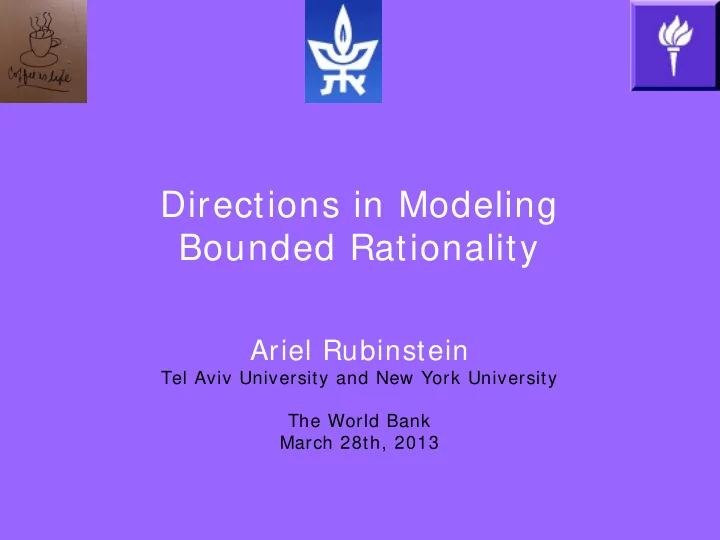

Directions in Modeling Bounded Rationality Ariel Rubinstein Tel Aviv University and New York University The World Bank March 28th, 2013
Jacob Glazer working on this paper in the University of Tel Aviv Cafes’ “Labs”
Scenario A "I went to a bar and was told it was full. I asked the bar hostess what time one should arrive in order to get in. I was told by 12 and once the bar is full you can only get in if you are meeting a friend who is already inside. I lied that my friend was already inside. Without being told, I would not have known which of the possible lies to tell in order to get in." (M.R. describing an actual experience at a Tel Aviv bar).
Scenario B As a part of the search process for a candidate for a particular job, a principal wishes to identify those individuals whose preferences over the set of objects {a,b,c} is transitive. Each individual has to answer three questions of the form: How do you compare the objects x and y? I prefer x to y (notated by x ≻ y) I prefer y to x (notated by y ≻ x).
The CODEX: R1: If a ≻ b and b ≻ c then a ≻ c. R2: If b ≻ a and c ≻ b then c ≻ a. R3: If a ≻ b and a ≻ c then c ≻ b. R4: If c ≻ a and c ≻ b then a ≻ b.
R1: If a ≻ b and b ≻ c then a ≻ c. R2: If b ≻ a and c ≻ b then c ≻ a. R3: If a ≻ b and a ≻ c then c ≻ b. R4: If c ≻ a and c ≻ b then a ≻ b. a ≻ b ≻ c a ≻ c ≻ b T P-T R a ≻ b Y Y N N Y N Y N b ≻ c N N Y Y Y N Y N c ≻ a N Y Y N N Y Y N
R1: If a ≻ b and b ≻ c then a ≻ c. R2: If b ≻ a and c ≻ b then c ≻ a. R3: If a ≻ b and a ≻ c then c ≻ b. R4: If c ≻ a and c ≻ b then a ≻ b. a ≻ b ≻ c ≻ a a ≻ b ≻ c T P-T R a ≻ b Y Y N N Y N Y N b ≻ c N N Y Y Y N Y N c ≻ a N Y Y N N Y Y N
The procedure we have ( essentially ) in mind: Step 1 . Examine whether your true profile satisfies the codex. If it does, then declare ( ) the true profile. If not, go to Step 2. Step 2 . Find a rule that is violated by your true profile (i.e., your true profile satisfies its antecedent but not its consequent). Change the consequent and check whether the modified profile satisfies the codex. If it does, then declare ( ) the new profile. If not, iterate step 2 (starting with the true profile). Step 3 . If you exhausted Step 2, declare ( ) your own profile.
I m plem entation problem : Standard approach: Cheating is easy and costless. Alternative approach: Cheating is limited (Green and Laffont 1986, Glazer and Rubinstein 2006) or costly (Kratik 2009) . Our current approach: The ability to cheat effectively depends on the way the mechanism is constructed and framed .
The platform : A persuasive situation : a speaker is trying to persuade a listener to take a certain action.
The speaker knows which profile is true. He wishes to persuade the listener to accept his request regardless of the true profile. The listener can either accept or reject the request. He wishes to accept the speaker's request only if the profile belongs to a given set A. The Leader-Follow er scenario: (1) The listener commits to a persuasion rule, a set of conditions ( a codex ) that the profile presented must satisfy in order to be accepted. (2) The speaker announces a profile. (a small problem: the speaker is BOUNDEDLY RATIONAL) (3) The listener applies the persuasion rule.
The Model
Exam ples
alltrue 1 allfalse
alltrue allfalse
Auxiliary Results
Truthful I m plem entation
I m plem entation
A little experim ent
Didactic W eb-Based Experim ents in GAME THEORY http: / / gametheory.tau.ac.il Site Programming and Design: Eli Zvuluny Possible Worlds Ltd
T P-T R Early Y N Y Y N N Y N Cheese Y Y Y N Y N N N Odd N Y Y N N Y Y N
1) Support the basic assumption 2) MRT 3) 68% of P’s who answered correctly followed the guide. 4) 56% of those were honest . Only 9% were not honest and chose unconfirmed profile. 5) An alternative theory: neighbor: A) (1,1,1) (212) have two neighbors each B) 221 also has a neighbor
Conclusions
Conclusions ( if you insist) (1) It may be necessary for the listener to use a codex that will guide the speaker to " exaggerate ". (2) If the circumstances in A are rare , then truthful implementation is possible. (3) If the circumstances in R are rare , then the optimal mechanism may require some of the deserving speakers to (successfully) cheat. and most importantly: The model is not intended to closely mirror real-life situations. As always.... it is just a fable and a suggestion for a direction for research into mechanism design with boundedly rational agents.
Recommend
More recommend